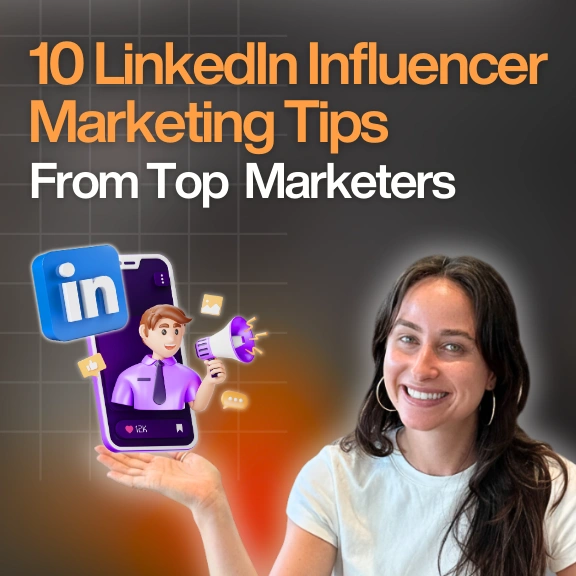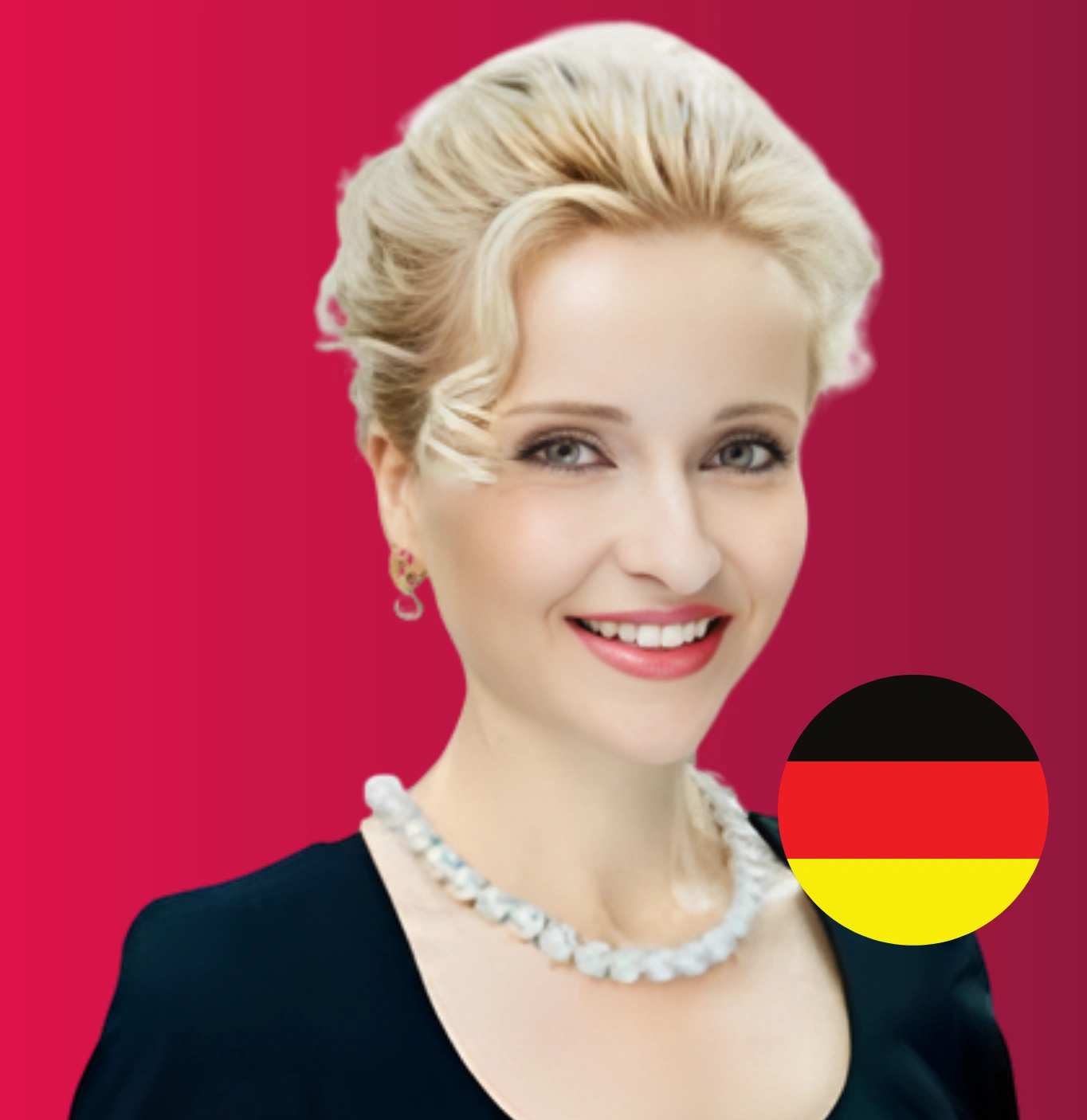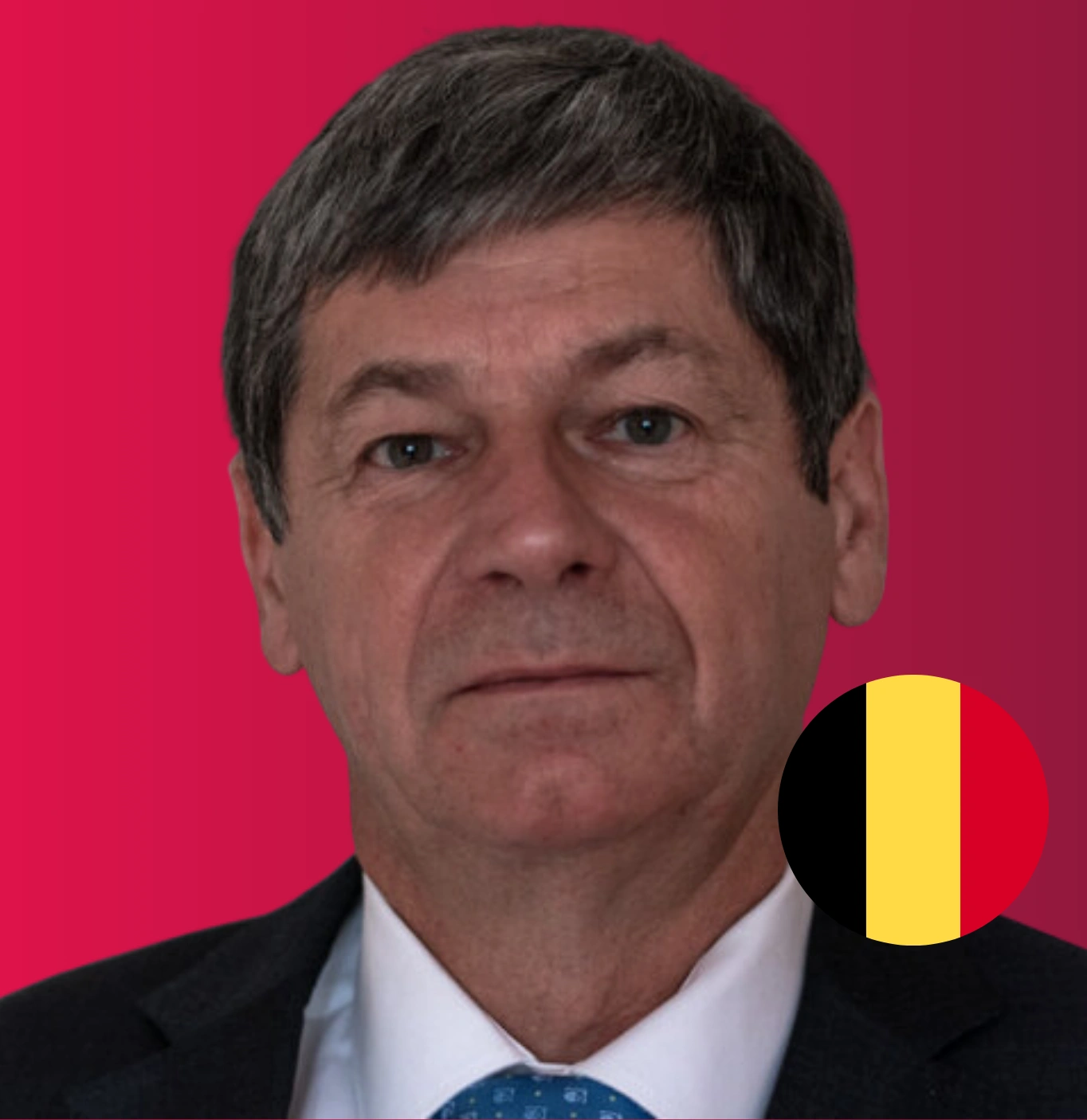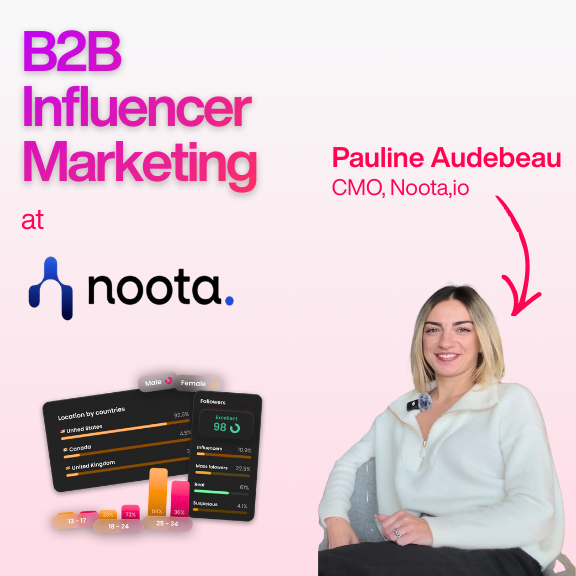Blog & Articles
Your ultimate ressource for the creator economy
Methodology & Rankings
About Favikon, rankings, tools & much more.
Insights
The recipe behind Favikon's viral & coveted rankings.
Free tools to power your influencer marketing workflows.
See Favikon users' success stories.
Get access to all Favikon rankings.
Become a Partner
Become an Affiliate
About the team behind Favikon
The place to talk creator economy, together


Featured Rankings

Here is the Top 50 Rising Video Creators on LinkedIn. Video is quickly becoming the platform’s most powerful format, with creators gaining more reach and engagement than ever. As Gen Z grows its presence and tools like BrandLink and Thought Leader Ads support content creation, LinkedIn is doubling down on video. This ranking, made in partnership with OpusClip, celebrates the creators leading this shift and aims to inspire anyone ready to start sharing through video.

Here is the Top 50 Rising Video Creators on LinkedIn. Video is quickly becoming the platform’s most powerful format, with creators gaining more reach and engagement than ever. As Gen Z grows its presence and tools like BrandLink and Thought Leader Ads support content creation, LinkedIn is doubling down on video. This ranking, made in partnership with OpusClip, celebrates the creators leading this shift and aims to inspire anyone ready to start sharing through video.
Inside Synthesia’s Global Influencer Marketing Strategy
Synthesia’s rise as a global leader is fueled by a smart influencer marketing strategy. Discover how strategic partnerships and creator collaborations drive their worldwide success.
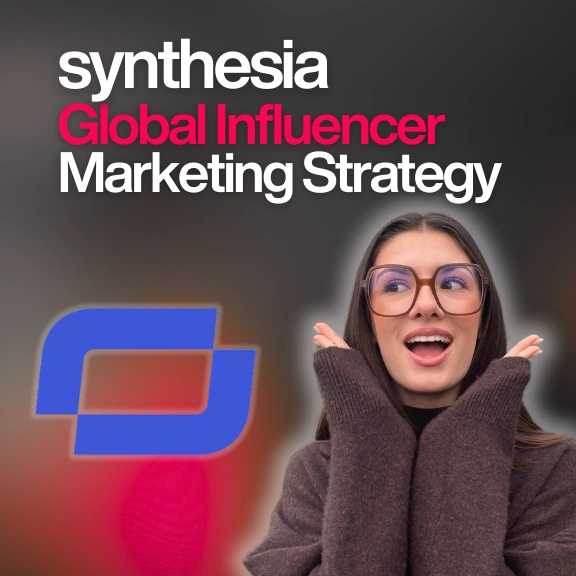


Megan Mahoney is an influencer marketer who uses data and real-world case studies to uncover what actually drives results in influencer campaigns. With a background in content marketing and over a decade of experience helping brands grow through strategy and storytelling, she brings a thoughtful perspective to creator partnerships and is deeply engaged in the evolving creator economy.
Check Brand DealsInside Synthesia’s Global Influencer Marketing Strategy
Synthesia is a rapidly growing AI video platform and influencer marketing has played a key role in its growth.
I had the opportunity to speak with Synthesia's influencer marketing manager, Ash Turner, and he provided a behind-the-scenes look into their influencer marketing strategy.
Turner also shared more granular insights about their influencer strategy, including:
- How they measure the ROI of influencer marketing
- How they choose platforms and influencers.
- How they approach budgeting and negotiation with creators.
- How they expand creator partnerships internationally.
Before we delve into the strategy, here are some statistics that highlight the success of Synthesia's influencer marketing approach.
Statistics Regarding Synthesia’s Influencer Marketing Strategy
Here’s a more detailed breakdown of their influencer marketing strategy from the past 12 months:
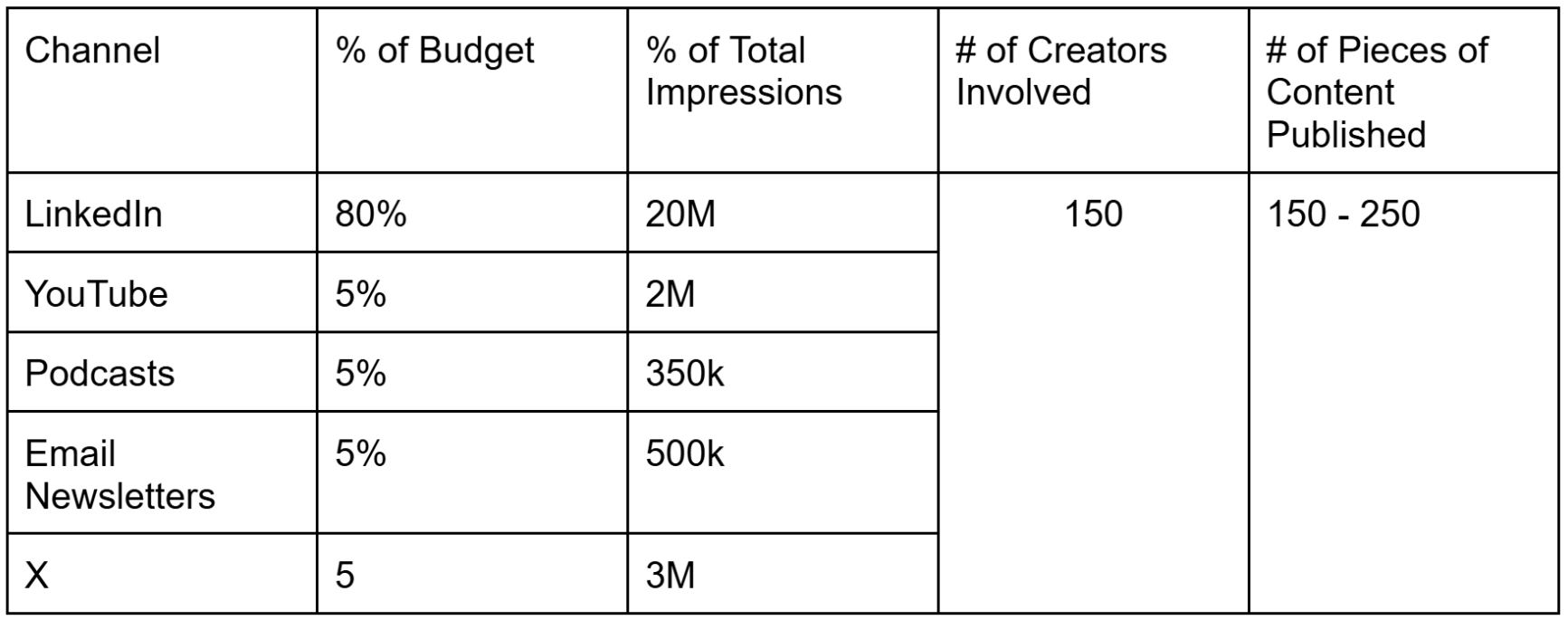
Inside Synthesia’s Influencer Marketing Strategy
Here's the step-by-step playbook Synthesia uses to run its influencer marketing strategy, along with actionable takeaways you can apply to your own influencer program.
#1: How to Select The Best Platforms To Prioritize
A logical answer to this question is to start with the creators who have your audience. Then, promote on the platforms where they're most active.
This was part of Turner's answer, but it's missing a key component.
Target your best customers – not just any customers.
Just from glancing at the website, you'll see that Synthesia offers plenty of plans for freelancers and even advanced content creators.
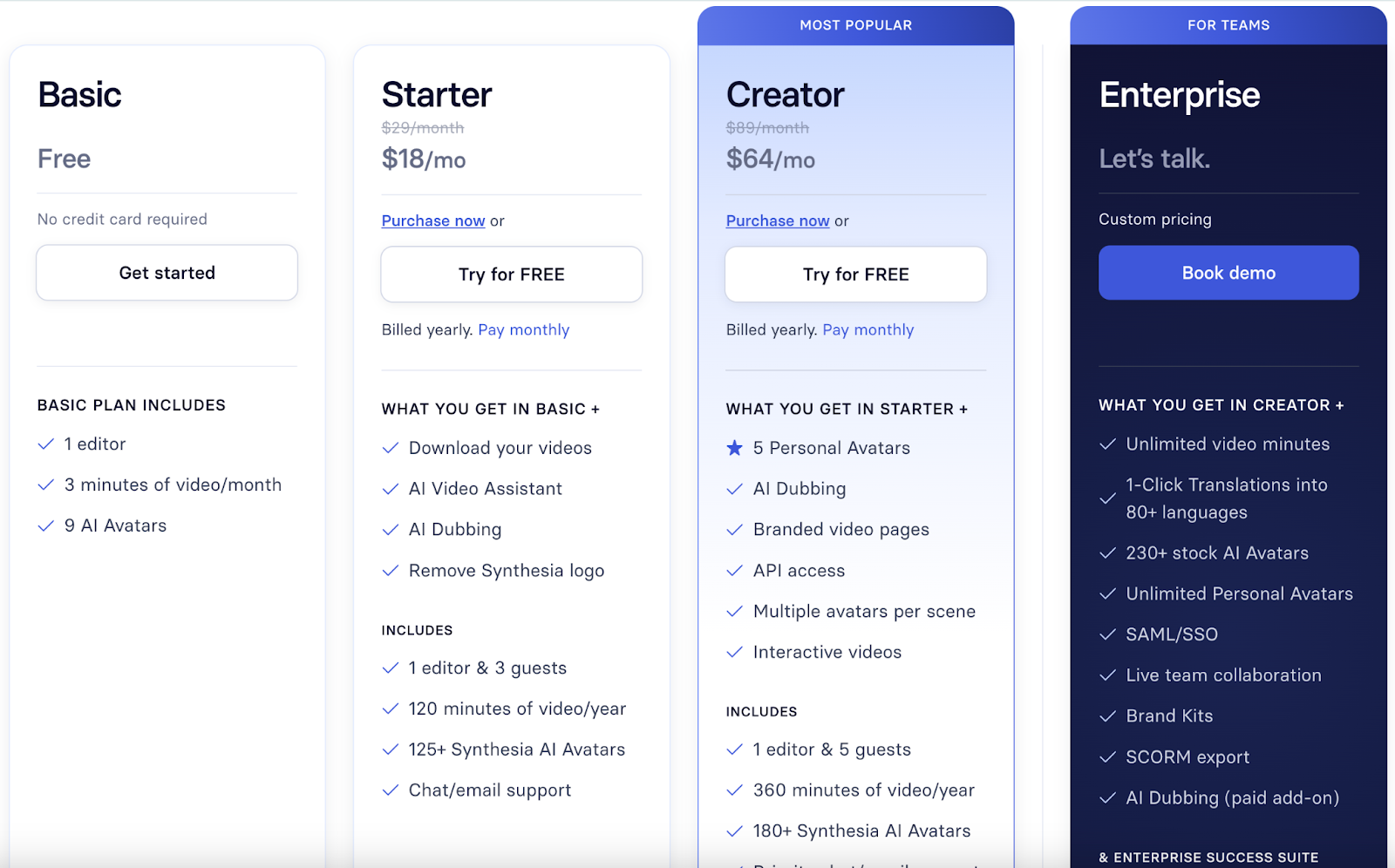
Freelancers and content creators likely make up the largest percentage of Synthesia’s total customer base. Therefore, you might conclude that TikTok and YouTube are the best platforms to focus your influencer efforts on.
However, Synthesia’s best customers are enterprise companies.
Therefore, I was surprised to learn that approximately 90% of Synthesia’s influencer activations are on LinkedIn.
In fact, Turner mentioned that their organic social team creates plenty of TikTok videos.
“It'll go viral, do 1 million, 2 million, 3 million views… so like cool quick wins that are nice to have, but in the grand scheme of things, they're not like core clientele,” says Turner.
@synthesia_ai Tutorial: How to Create Your Own AI Doll(Action Figure) with ChatGPT 📸 Step 1: Take a selfie or grab any photo 🤖 Step 2: Open ChatGPT and select 4o model 🎯 Step 3: Upload the image and click “create image” 📝 Step 4: Use this prompt below Create an action figure toy based on the person in the photo. Next to the figure, there should be the toy’s equipment, each in its individual blisters. Don’t repeat the equipment under any circumstances. {insert equipment 1} {insert equipment 2} {insert equipment 3} The card holding the blister should be a {insert color}. Also, on top of the box, write {insert title}. The figure and equipment must all be inside blisters. Visualize this in a realistic way. #ChatGPT #actionfigure #AIimagegenerator #ai #doll #dolltrend #synthesia #prompt ♬ original sound - Synthesia_AI
However, that doesn’t mean Synthesia’s team never tests other channels. For example, if a TikTok influencer has an audience of highly engaged decision makers at Fortune 500 companies who need video solutions, they’d certainly be open to testing it out.
Key Takeaway
Select the platforms where your most profitable customers engage – not just the majority of your customers.
To discover where your audience is hanging out, ask the paid media team which channels are driving the most profitable customers. Then, start with those channels.
Aligning with the paid media team from the start is also highly beneficial as you’ll be able to later repurpose influencer content as creative for paid ads on those channels.
#2: How to Select Influencers
The short answer to this question is a four part checklist:
- ICP/Audience match
- Depth of trust and content quality
- Reach and engagement
- Campaign/content fit
However, there’s plenty of nuance to each checkpoint, so we’ll discuss them in more detail.
ICP/Audience Match
Similar to selecting the right platforms, the most important factor when selecting influencers is audience alignment.
Does this influencer have the attention and trust of decision-makers at companies that purchase Synthesia's enterprise plan? (Not just any company who could use Synthesia).
An easy place to start finding influencers who match your ICP is simply sorting by niche in a tool like Favikon.
For example, IT and Cybersecurity are a subset of Synthesia's audience, and here I can see 887 LinkedIn creators in the cybersecurity niche who earn a minimum of 100 average engagements per post:

However, just because someone is in your niche doesn't mean that 100% of their audience is your ICP.
Two influencers might have 50,000 followers. Both of them might have followers who match your ICP.
Yet perhaps only 65% of Influencer A's audience matches your ICP, while about 90% of Influencer B's audience matches your ICP.
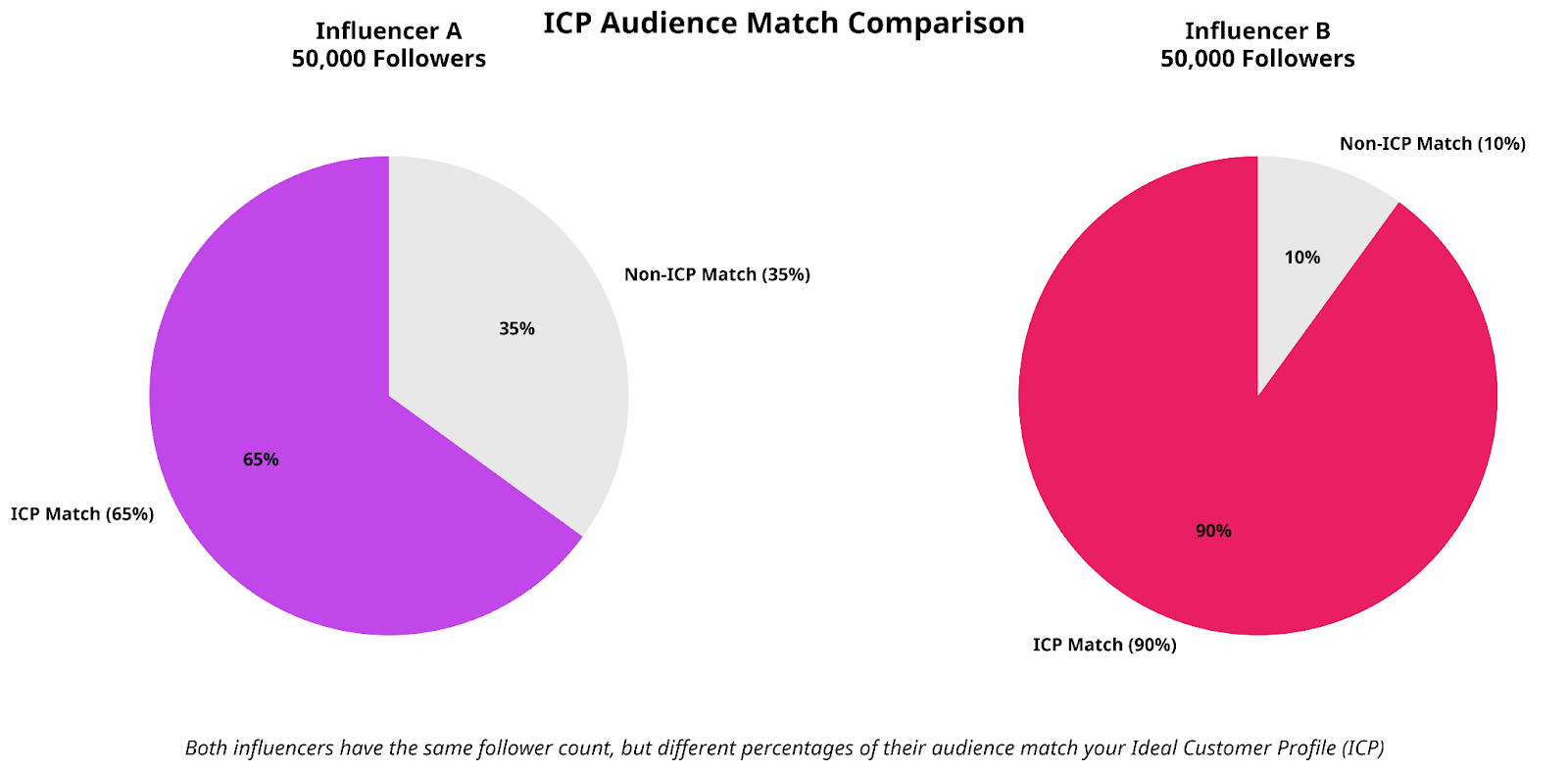
To gauge the approximate percentage of followers who match your ICP, skim the comments of the creator's recent posts and look at the titles of each person commenting on the post.
For example, you can see that the majority of this person's audience are B2B marketers:
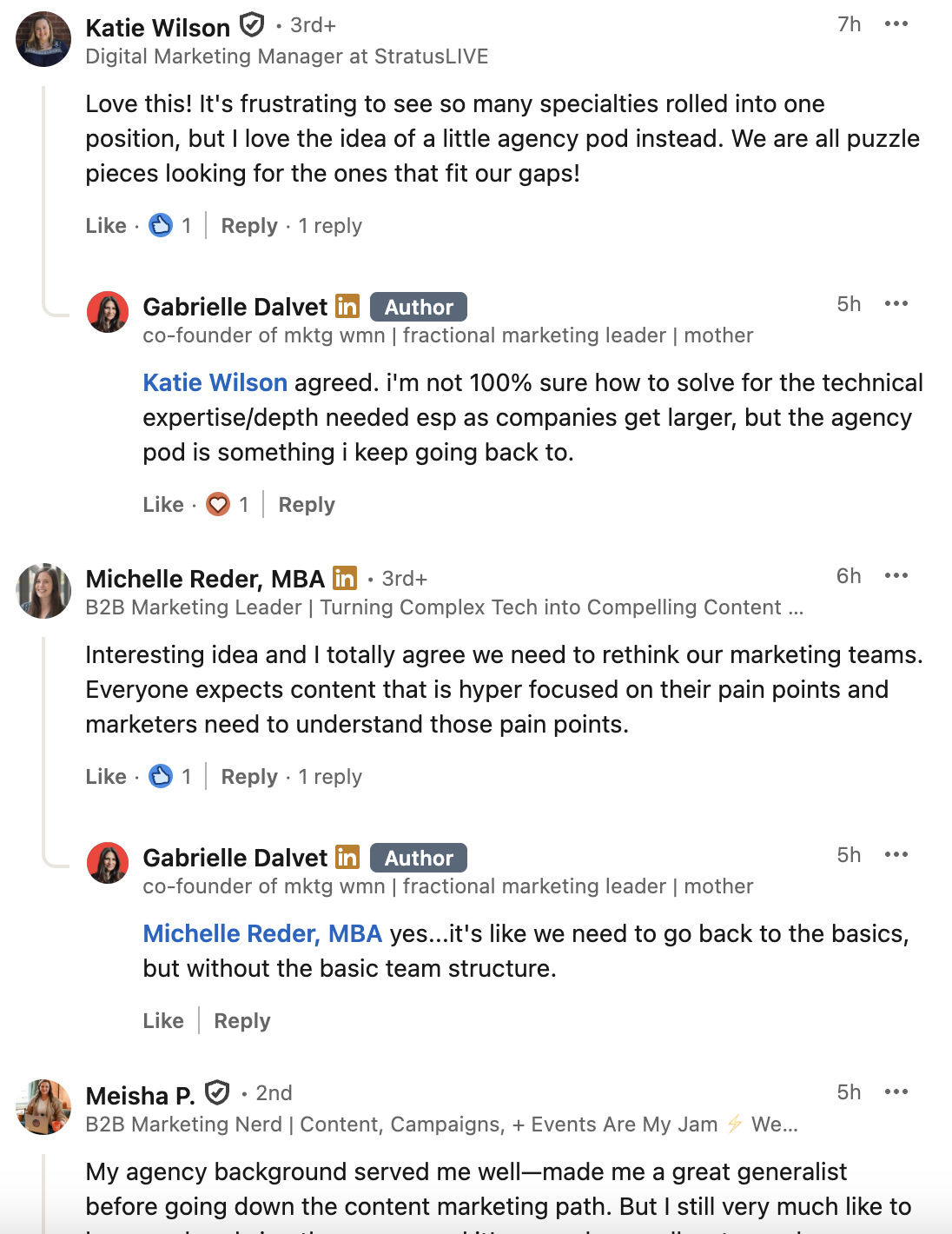
Depth of Trust
Just like with your own circle of friends, there are some people whose recommendations you take more seriously than others.
Creators who are genuine experts in their field and create original content that brings new insights to the conversation tend to have deep trust with their audience than those posting lifestyle or meme content.
Therefore, the Authenticity Score in Favikon is a reliable indicator of an influencer's depth of trust.
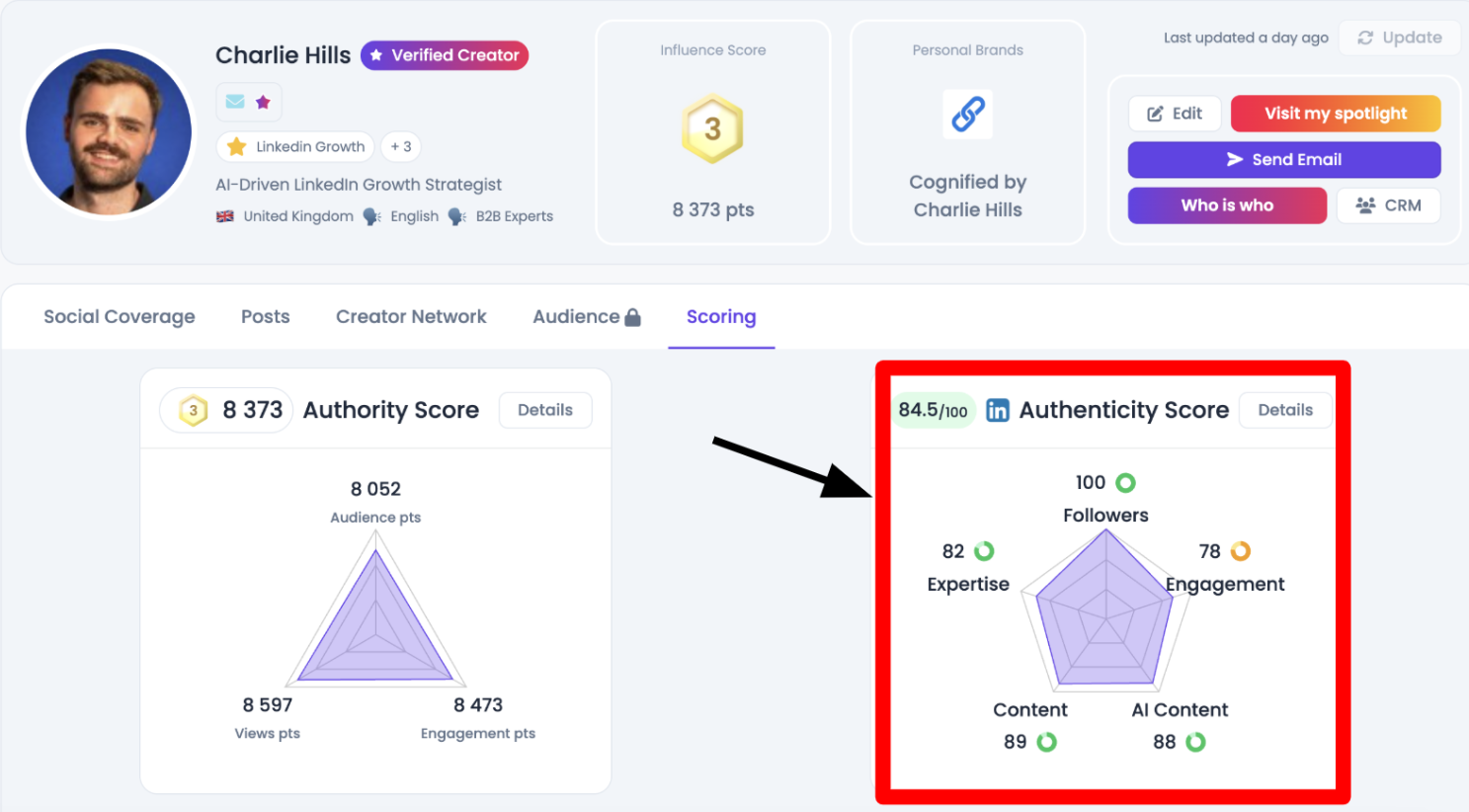
The authenticity score is calculated based on a variety of factors that correlate with the depth of trust, like:
- Followers
- Engagement quality
- AI content
- Post Content
- Industry Expertise
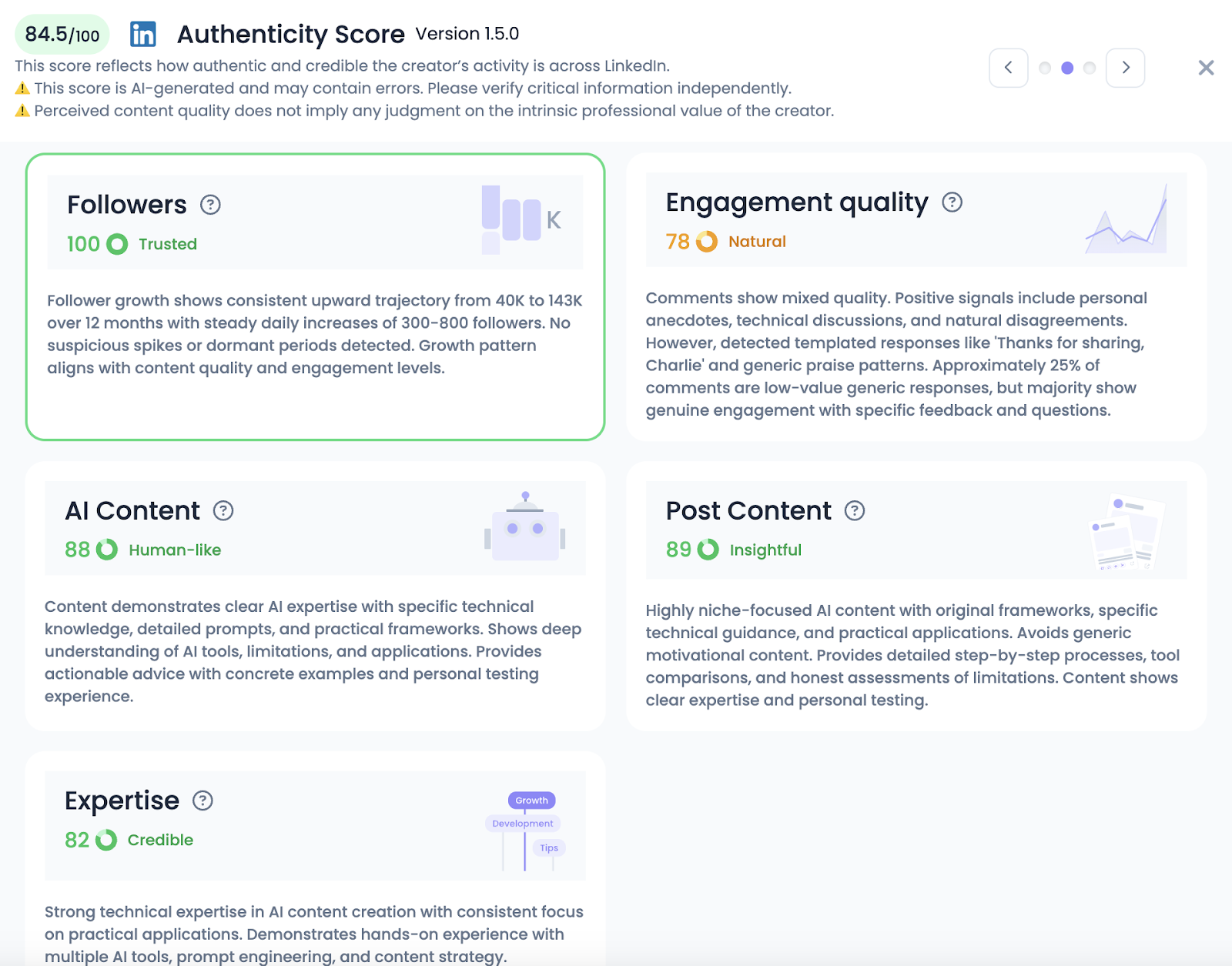
Impressions and Engagement
Like many influencer marketers, Turner agrees that follower count isn’t necessarily a useful metric as it doesn’t always correlate with how many people (particularly people who match your ICP) will see the content and take the desired action.
Impressions and engagement are a much better metric.
However, more impressions and engagement also come with a higher cost.
This begs the question: Should you work with many micro creators or one or two macro creators?
There isn’t a clear answer to this question, but here’s how they approach it at Synthesia:
“I think micro influencers do a really good job of pushing a message [e.g., product use case posts targeting a specific subset of your ideal customers, like IT and Cybersecurity]. And I think macro influencers do a really good job of generating top of funnel trust and brand awareness. That's why it's important to have both,” says Turner.
Turner also elaborated that micro influencers tend to have less audience overlap than macro creators.
For example, 100,000 impressions across a variety of micro creators might reach 80,000 unique people, whereas 100,000 impressions across three macro creators might only reach 50,000 unique creators.
In contrast, here’s how Synthesia incorporates macro creators into their influencer strategy:
“We have a handful of macro creators that really embody the brand. We work with them over a longer period of time, develop that partnership, and do bigger activations with them.”
For example, they’ve worked with Andrew Bolis on several occasions:
“So it's not just like a LinkedIn post here and there. Sometimes we invite them to a London studio, we'll create content with them,” says Turner.
Campaign/content Fit
Finally, if the campaign concept deviates significantly from the creator's typical style of content, it may not perform well.
For example, if the creator typically posts comedic shorts or memes, a how-to style post walking through your product probably won't perform well.
Instead, scroll through their content beforehand to ensure the style of your campaign aligns with the type of content they typically post.
For example, this creator is more of a lifestyle creator. People follow her for fun, light hearted content about herself:

Therefore, she might not be the best fit if you're promoting a new piece of original research and want each creator to post a thought-provoking insight from the data.
Of course, one solution to content/campaign alignment issues is simply giving creators free rein to package your message in a format that aligns with their existing content.
For example, Synthesia worked with Fatima Khan to create a LinkedIn post. Here's her sponsored post:
If you scroll through her LinkedIn feed, you’ll see that the sponsored post blends in well with the style of the rest of her content:

Therefore, scroll through that creator’s content before sending them an offer.
Also, if you plan to do a video campaign, make sure that the creator has experience recording videos. Otherwise, you may have poor quality video or audio, which could reflect poorly on your brand.
Key Takeaway
Avoid using follower count as the primary metric for selecting influencers. Instead, use these four criteria:
- ICP/audience match
- Depth of trust
- Impressions and engagement
- Campaign content fit
#3: How to Contact Creators and Negotiate Partnerships
Earning a response from creators is surprisingly challenging.
Synthesia was in a unique position in that they began sponsoring LinkedIn creators about two to three years ago, so the team already has some excellent creator connections.
“Now those relationships have paid dividends. It's a lot easier to open these conversations because when I speak to some creators, they're like, I've seen this creator work with you guys already. I'd be open to a chat,” says Turner.
So what if you don’t have those relationships in place and you’re struggling to receive responses from creators?
First, simply engage with their content and be present in your industry. You can also introduce yourself to these creators at events.
As you work with more creators, you’ll build credibility and find it easier to receive positive responses from creators you contact. Some creators will also reach out to work with you.
Once you’ve opened a conversation with a creator, you’ll have to agree on a price.
This can be challenging because there is no set standard for LinkedIn partnerships. As LinkedIn influencer marketing is still in its infancy, there's a lot of variation in pricing and creators value their promotion differently.
If you want a benchmark to start the negotiation, you can look up any creator in the Favikon dashboard and see an estimated rate.
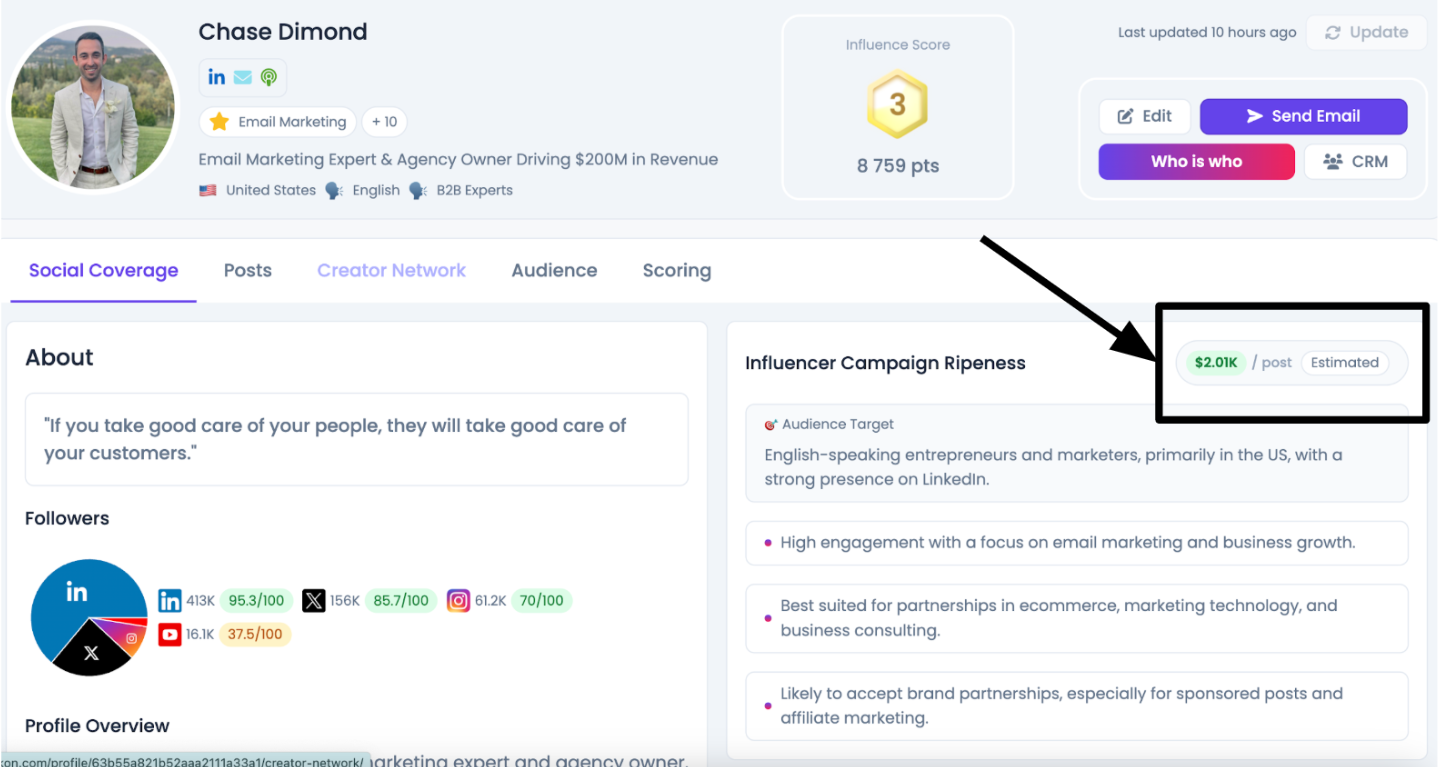
This estimate is based on verified rates from nearly 150 LinkedIn creators and considers factors such as follower count, engagement rate and the creator’s Authenticity Score.
Once you have an estimate, have a transparent conversation with the creator.
“Always go into a call with an expectation of, this is the max that we can realistically afford for this person… And then be transparent with creators and say, look, I totally appreciate this is where you're at. Unfortunately, our budget for this activation is around here,” says Turner.
If the budget is close, you can offer additional incentives, like affiliate links or rights to use the content in ads.
“I'd say nine times out of ten, we can come to an agreement with a creator that works on both ends,” says Turner.
Actionable Takeaway
Enter the conversation with a dedicated budget and attempt to reach an agreement that includes other benefits, such as an affiliate link or complimentary access to the product. Often, you'll be able to come to a mutually beneficial agreement, but also be prepared to politely walk away.
#4: How To Craft an Effective B2B Influencer Campaign
B2B enterprise purchases typically have long buying cycles that last many weeks.
You can't expect someone to see the product and book a demo or sign up.
However, if the audience sees the sponsored post today and then scrolls past it, they will likely have forgotten about your brand by next Tuesday.
Instead, creating a lower ask offer pulls them into your brand's ecosystem, allowing you to capture a higher percentage of impressions and turn them into leads.
For many of the Synthesia campaigns, the offer was a LinkedIn live event where they would unveil a new feature.
However, don’t just ask your creators to promote an event.
Come up with a creative hook. For example, when Synthesia launched its AI dubbing feature, it created a campaign featuring several creators who spoke in multiple languages.
This was highly effective because it was both viral and illustrated the product’s capabilities (and value).
As a result, this campaign had a lower CPM than others.
Here’s how Turner explained it:
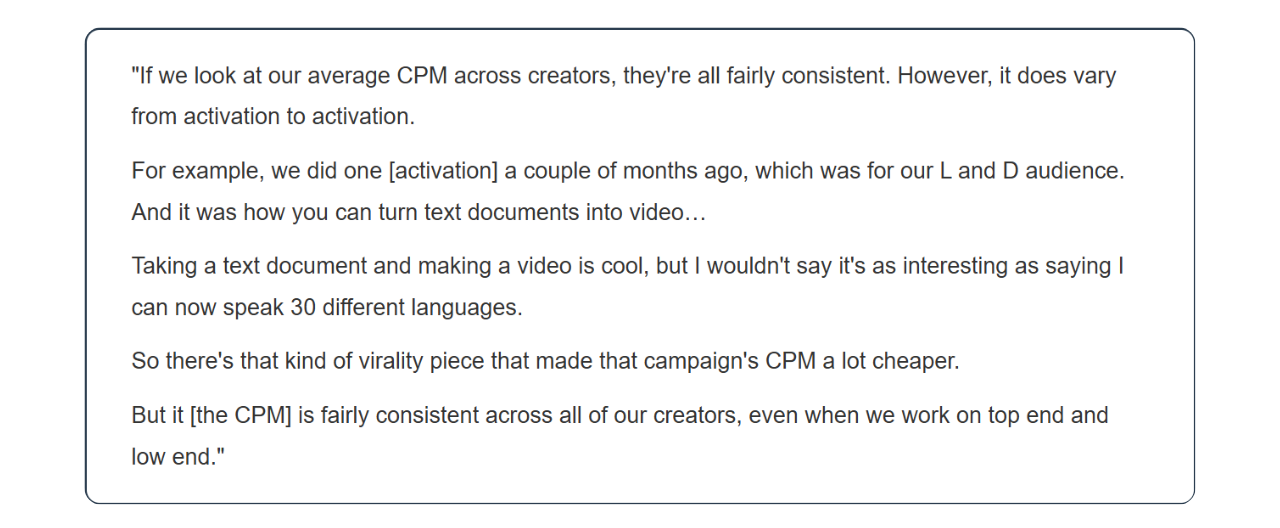
That said, not every campaign needs to have a viral hook. There’s nothing wrong with a simple product activation campaign that illustrates how a product works.
However, if you want to reduce your CPM, spend some time brainstorming more creative ways you can portray your brand.
Key Takeaway
Reduce your CPMs and increase creator response rates by dedicating more time to the campaign's creativity.
If you're selling an enterprise B2B product, drive users to a free resource, event, or tool to capture them as leads. Don't immediately ask them to sign up for your product, but ensure there's a clear call to action.
#5: How to Measure The ROI of Creator Partnerships
Influencer marketing is an 80/20 game, so set expectations with executives from day one.
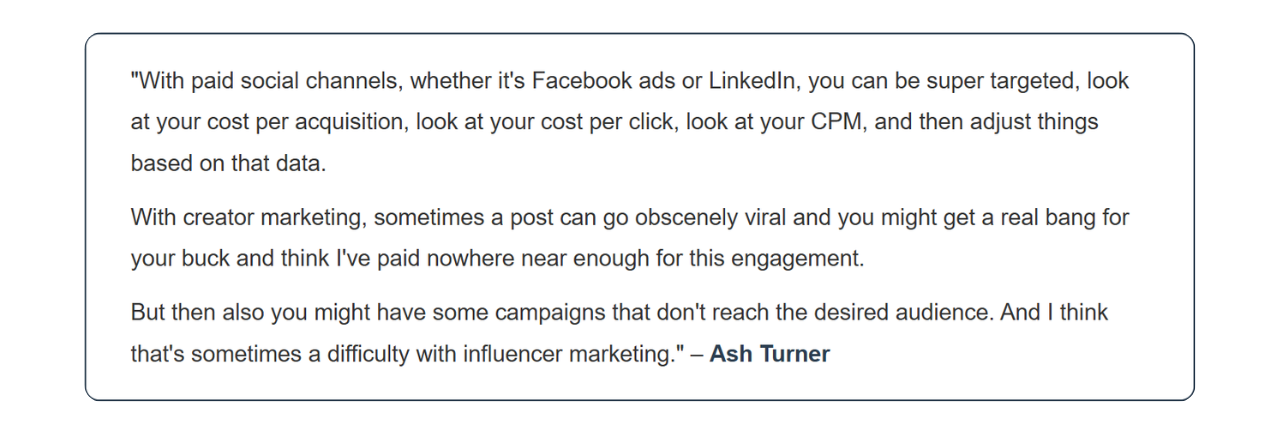
Additionally, measuring the ROI of influencer marketing is particularly challenging for enterprise B2B, because decision makers won’t convert after a single touchpoint with your brand.
“I would say nine times out of 10, influencers are seen as that top of funnel brand awareness piece for us,” says Turner.
Therefore, impressions and reach are key metrics they use to guide their influencer program.
Hopefully your creators are promoting a low ask offer, like a free tool, checklist, or live event. If so, you can track signups as well.
“Typically, if we're promoting a new feature or product, there will be a LinkedIn live event talking about that feature release. So we'll look at the spike in engagement or signups for the LinkedIn event.
Typically our main goal that we're looking at is impressions and reach, seeing that kind of bigger brand awareness piece,” says Turner.
Key Takeaway
If you're targeting an enterprise audience, treat influencer marketing as a top of funnel brand awareness channel, so track engagement and reach as well as signups for your free offer.
#6: How To Maximize The Value of Creator Partnerships and Scale
Beyond simply hiring more creators, how do you profitably scale impact and maximize ROI?
First, analyze your top performing creator content and ask to acquire the rights to use it as a paid ad.
Synthesia also develops long term relationships with a handful of macro creators and then works with them to create organic content.
Finally, consider expanding to other countries and regions (assuming your audience is global).
Not only can you tap into new audiences, but you also may earn more reach at a lower cost.
For example, Synthesia recently expanded to hire creators in Germany.
They worked with a German agency to manage the expansion, and they’re planning to continue expanding to other countries.
Key Takeaway
Invite influencers to create content with your brand so that you earn branded organic content and negotiate for the rights to reuse their content in ads.
If you have a global audience, expand to different regions. You can work with influencer agencies in those areas for initial support.
Take Your Influencer Marketing To The Next Level
As seen in this global Influencer marketing case study, the 80/20 of a great influencer marketing program is about building and managing the right partnerships with the right people.
However, finding the right influencers, building relationships with them, and managing content approvals is challenging.
To solve these problems, we built Favikon. It’s an all-in-one influencer marketing platform that supports all major social media platforms, including LinkedIn.
This makes it easy to find any influencers, including B2B influencers.
Try Favikon today to see how it can help you find better influencers and run better campaigns in less time.
Related Articles
See all the articlesResources











.png)
